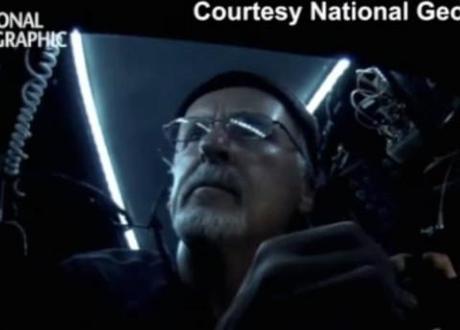
Director James Cameron in the 'Deepsea Challenger', via National Geographic/YouTube
Titanic director James Cameron has made another big splash – this time with footage of his voyage to the deepest part of the ocean. Cameron became the first person to undertake a solo dive to the bottom of the Mariana Trench, seven miles below the surface of the western Pacific.
Equipment failure cut short the director’s undersea exploration in submarine ‘Deepsea Challenger’. But Cameron remained upbeat, according to Reuters, and described his awe at the perfect isolation of the sea floor: “When I got to the bottom … it was completely featureless and uniform… My feeling was one of complete isolation from all of humanity.”
Cameron, famous for films including Avatar and True Lies, has shown a previous passion for underwater exploration, producing a number of deep-sea documentaries over the years. But what was the point of his latest venture?
Titanic effort. At first glance, footage released of Cameron’s dive may not seem particularly exciting, wrote Jacqui Goddard at The Daily Beast: “Yet in just 26 seconds, this seemingly scant-on-thrills offering represents a record of one of the most significant feats of human exploration.” The failure of the craft’s hydraulic arm meant the director was unable to collect any deep-sea creatures, but this is something he intends to remedy in the future. “News that he not only plans to go back but also to turn his project into an ambitious, longer-term program of undersea research, has prompted delight in the deep-sea exploration community,” Goddard said.
View footage of James Cameron’s underwater exploration below.
Aliens. Cameron may have struggled to collect the range of samples he’d hoped for, but the director did bring back a small quantity of mud along with the footage. “The science team is hopeful that the small sample Cameron took of the trench’s sediments, along with the sub’s constantly whirring cameras, will provide some new insight into the remote underwater realm,” said National Geographic, partner on the project. “The mud, they say, could contain exotic species of microbial life that may not only advance our understanding of the deep ocean but also help in the search for extraterrestrial life.”
The Abyss. Michael Hanlon puts Cameron’s voyage into context in The Daily Mail: “About 3,000 climbers have summited Everest, around 550 people have traveled into space and 12 men have walked on the Moon. But only three people have ever visited the deepest point on the ocean floor.” According to Hanlon, a previous expedition showed that the Mariana Trench is desolate, but that doesn’t mean we can’t learn from it: “The abyss may be black and cold but it is in scientific terms hugely interesting. There is no more extreme environment on the Earth’s surface.”
True Lies. Writing ahead of Cameron’s return, Roz Kaveney suggested on The Guardian’s Comment is Free that the director’s trip is thrilling partly for the potential to inform his cinematic art. “What Cameron finds in the depths of the sea will be transmuted (because he is a true artist, even if you happen not to have liked Avatar) into art,” wrote Kaveney. “The exploration of the real world and the exploration of mere possibilities build on each other constantly.” Shame, therefore, that Cameron appears not to have actually seen any creatures this time round.

